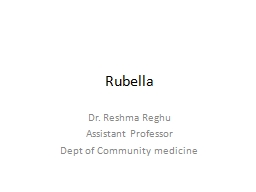

Assistant Professor Dept of Community medicine Introduction Rubella or german measles It is an acute childhood infection usually mild of short duration approximately 3 days and ID: 1044740
Download Presentation The PPT/PDF document "Rubella Dr. Reshma Reghu" is the property of its rightful owner. Permission is granted to download and print the materials on this web site for personal, non-commercial use only, and to display it on your personal computer provided you do not modify the materials and that you retain all copyright notices contained in the materials. By downloading content from our website, you accept the terms of this agreement.
1. RubellaDr. Reshma ReghuAssistant ProfessorDept of Community medicine
2. IntroductionRubella or german measles It is an acute childhood infection, usually mild, of short duration (approximately 3 days) and accompanied by low-grade fever, lymphadenopathy and a maculo-papular rash. Infection in early pregnancy may result in serious congenital defects, including death of the foetus.The disease is worldwide in distribution and tends to occur in epidemics, in non-immunized populations, every 6 to 8 years
3. History1941 when Norman Gregg, an ophthalmologist reported an epidemic of congenital cataracts associated with other congenital defects in children born to mothers who had rubella during their pregnancies. This discovery changed the concept that rubella is not merely a benign disease of childhood but also one with teratogenic potential. In 1962, the virus was isolated; in 1967, an attenuated vaccine was developed.
4. Epidemiological determinantsAgent factorsHost factorsEnvironmental factors
5.
6.
7.
8. CLINICAL FEATURESA large percentage of infections are asymptomatic (50- 65%)PRODROMAL STAGE: Mild Coryza, sore throat, low grade feverLYMPHADENOPATHY: Post auricular and post- cervical lymphadenopathy appears as early as 7 days before the appearance of rashes. The glands found enlarged for 10 to 14 days after the rash.
9. RASHFirst indication of the disease in children.Appears first on face, within 24 hours of onset of prodromal symptoms.Minute, pinkish, discrete, macular in appearance. Not confluent as in measles.Rashes spread to the trunk & extremities.Rashes spread much faster and clears more rapidlyIt disappears by the third day.Conjunctivitis may appear
10.
11. DiagnosisVirus isolation and serologyHaemagglutination inhibition test (HI)- standard test for RubellaDetection of Ig G
12. CONGENITAL RUBELLARefers to infants born with defects secondary to intra uterine infection or who manifest the symptoms after birth.Chronic persistance of virus in the new bornVirus is detectable in pharyngeal secretions, multiple organs, csf, urine and rectal swabs.Viral excretion last for 12- 18 months after birth.Rubella infection inhibits cell division results in congenital malformations and low birth weight
13.
14. The first trimester is the most disastrous time for foetus as the organs are developing.Infection during this period results in abnormalities- 85%Infection during second trimester- 16 %Birth defects are common if maternal infection occurs after 20 weeksInapparent maternal infection result in foetal death and spontaneous abortion.
15.